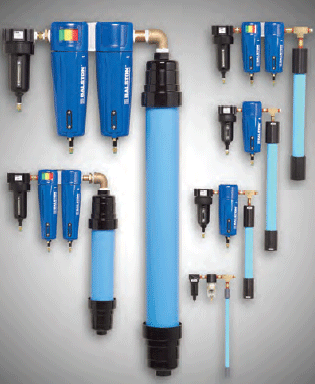Compressed Air Dryer Review
Hydraulic and Pneumatic Knowledge
Compressed air dryers are used to remove water and other contaminants from compressed air. Vapor is removed from compressed air to prevent condensation from occurring and to prevent the water vapors from interfering in sensitive industrial processes and equipment. Compressed air dryers use various technologies to remove the contaminants, such as; condensation- refrigeration, chemical adsorption, regenerative desiccant dryers, often called "regens" or "twin tower" dryers, and deliquescent dryers . Other technologies utilized are membrane and in-line compressed air dryers. The air may be dried in multiple stages using different technologies to achieve maximum performance of vapor removal or drying.
Refrigeration compressed air dryers employ two heat exchangers, one for air-to-air and one for air to refrigeration. However, there are that combine the technoloiges in the form of a heat exchanger. The compressors used in this type of dryer are usually of the hermetic type and the most common gas used is R-134a. The goal of having two heat exchangers is that the cold out going air cools down the hot incoming air and reduces the size of compressor required. At the same time the increase in the temperature of outgoing air prevents re-condensation.
The most common set up for a refrigeration dryer is to installed after a pre-filter and a receiver made from galvanized steel. The pre-filter functions as a protection for the dryer, while the receiver maintains line pressure and condenses a good amount of water.
The other major type compressed air dryer is the desiccant dryer. The compressed air is pressed through a cylinder filled with silica gel or other desiccant material. The silica-gel brings the dewpoint of the water in the air down to approximately -40 degrees Celsius. In practice two cylinders with silica-gel are used; one for drying the air, while one vessel is in use, the other vessel is being regenerated. In general the changing of the cylinders is done automatically. The regeneration of the desiccant vessel can be during three different methods: Heatless drying which uses part of the dry compressed air coming from the other vessel to dry the desiccant in the vessel being generated.
As of the year 2000, most manufacturers started producing energy saving dryers that do not make use of a hot-gas by pass. These dryers can save up to 40% in total energy and can consume only 10% of the max power when idle. They employ digital control and sometimes variable speed compressors.
When using a desiccant or chemical type compressed air dryer one should consider the stages and regeneration method. Stages include single stage and double stage. Choices for regeneration method include heatless regeneration, internally heated regeneration, and externally heated regeneration. In heatless regeneration by means of expanding cold dry air to near atmospheric pressure inside the regeneration tower, the dryer air picks up moisture from the saturated desiccant bed and is then purged to atmosphere. In an internally heated regeneration dryer the process air enters the dryer through the inlet piping, is then dried as it passes through the desiccant bed, and discharges through the outlet piping as dry air. Regeneration of the desiccant is accomplished at atmospheric pressure, using steam or electric heaters, embedded in the desiccant bed. In an externally heated regeneration dryer process air enters the dryer through the inlet piping, is then dried as it passes through the desiccant bed, and discharges through the outlet piping as dry air. Reactivation is accomplished using a reactivation blower or a cooler.
Power requirements for compressed air dryers and associated requirement vary and include; DC power, AC single phase, and AC three phase and some technologies do not require any external power source. Typical dryer features include pressure gauges, integral filters, temperature sensors, condensation drains, and NPT type threaded features.
Important considerations when specifying or designing for compressed air dryers are the drying capacity, maximum operating pressure, motor power requirements, and recommended maximum and minimum operating temperature.

Courtesy Balston
Other Applications:
- General Compressed
- Air Mainlines
- Process Controls
- HVAC Systems
Instrument Cabinets - CNC/CMM Machinery
- Fire and Sprinkler Systems
- Pneumatic Controls
- Dry Air for Hazardous Areas
- Chemical Blanketing and Packaging
- Electronics/Dry Boxes
- Laser Optic